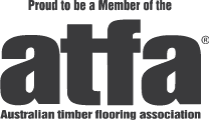Care and Maintenance
Timber floors vary in ease of maintenance depending on the type of coating used and the severity of use and always greatly benefit from regular care. In doing so, the life of the floor finish and floor are greatly enhanced. However, at some stage the floor will need to be rejuvenated and this usually requires buffing back and re-coating.

GENERAL CARE INCLUDES
- Regular sweeping – dirt, sand and grit can be very abrasive
- Dust-catching mats at external doorways – we suggest Nomad type mats at exterior doors with slip-resistant mats just inside the door. Wait at least 14 days after coating the floor before placing mats directly on to the timber floor
- Prompt cleaning of spills with a dry cloth or paper towel. For sticky substances moisten the cloth slightly and dry as you go
- Avoid dragging furniture over the coated surface. Fit protective felt pads on static furniture and chairs
- Dust, sweep, vacuum or mop regularly. Worn vacuum heads will scratch your floor
- Not wearing stiletto heels as damage can be accelerated by the combination of dust, grit & points
Although a floor may be walked on after initial curing, some precautions are necessary with a newly finished floor until the coating system has fully hardened and this may take in the order of two weeks.
Use of the floor before the full cure has been realised can result in increased tendency for scuffing and scratching.
It is recommended that rugs are not laid until after the floor finish has fully hardened. Additionally, rugs with rubber backings should never be used as these may tend to stain the applied coatings.
While light furniture can be replaced and used during this period, it should be ensured that furniture protection felt pads are attached to the feet of tables and chairs etc and furniture such as chairs should be lifted. Similarly, it should also be ensured that heavy items such as fridges are moved carefully into position, and at no time should they be dragged over either newly finished or fully cured floors.
Consideration should also be given to chairs with castors as they can indent softer timbers and also cause premature wear of the coatings they are in contact with. Again these should not be used until the finish has hardened and barrel-type castors are less likely to damage a floor than ball castors.
ONGOING CARE AND MAINTENANCE
Ingress of Grit and Direct Sunlight
There are some things that are enemies to timber floor finishes and one of these is sand or grit that can be brought into the house with footwear. These small particles act like sandpaper resulting in scratches in the floor. Mats placed both outside and inside external doors provide a simple and effective means of significantly reducing grit from entering the house. Similarly, in high wear areas, runners and rugs can be effective and can also add to the decor of the house. The kitchen floor generally experiences high wear and therefore a floor rug in this area can be particularly beneficial.
Another aspect that should be considered is the amount of direct sunlight that is reaching the floors. Direct intense sunlight can contribute to gapping and possible cupping of boards. It will also cause the colour of both boards and finish to change with time. Some floor finishes are more prone to darken with age and direct sunlight accelerates this process. Filtered sunlight through sheer curtains or blinds provides an effective means of slowing the colour change processes and is also effective in controlling gap size and possible cupping. In some instances, it may be decided that window coverings will not be used, and if the sunlight has not been controlled by patio roofs or awnings then floors rugs can be used.
Maintenance Plan
Establishing a regular cleaning program will greatly assist in keeping floors in pristine condition. There are many aspects that affect how often the floor requires cleaning and these include the degree of grit present (particularly from children and pets), type of exterior and interior matting used, the level of traffic, type of footwear and general conditions of the area outside the house. Spills should be mopped up when they occur and any leaks must be attended to immediately. Failure to attend to leaking pipe work can result in severe problems with a floor particularly when laid over sheet flooring or directly adhered to a slab. Scuff marks or stubborn stains may be removed with light rubbing using a wood floor cleaner. As some cleaners can attack certain types of coating, use where possible the cleaning regime specified by the coatings manufacturer – alternatively always test rub an isolated area of floor to verify compatibility of the cleaner used to the coating.
For regular cleaning of domestic floors an antistatic mop provides an effective means of collecting dust and grit. Continual walking on a dirty floor will quickly damage the finish. If a vacuum cleaner is used then the condition of the brushes should be regularly checked. If they have worn thin, contact of the metal head on the floor can result in scratching. Also, do not use hard head vacuum cleaners as they will invariably cause fine scratches on the floor. Steam mops are not recommended on polished floors as they can cause damage to certain types of coatings. They may also cause ‘lipping’ on floating floors.
On a monthly basis floors can also benefit from damp mopping. Providing the mop is only damp and the finish is in good condition, mopping carried out correctly will not affect either the finish or the timber. Damp mopping provides an effective deep clean and should be undertaken with a neutral pH wood floor cleaner or product recommended by the finish manufacturer. Harsh detergents or abrasive cleaners are to be avoided as are use of methylated spirits and vinegar as they can chemically attack some types of coatings e.g. waterborne polyurethanes and penetrating oils. After wetting the mop it should be wrung out until it is moist and the floor can be mopped in this condition. Using clean water, a final mopping with a mop wrung out till it is ‘dry’ may be used to further remove excess moisture on the boards. Periodically the protective pads on furniture legs should also be check to ensure that they are clean of grit or in need of replacement.
Re-coating
Timber floors are subject to different wear patterns and it is in areas of higher wear that there will initially be signs that the floor requires re-coating. It is important to ensure that excessive wear has not occurred if a total re-sand and re-finish is to be avoided. The finish should be inspected in the high wear areas and if a few drops of water bead on the surface then the finish is still intact and may require cleaning rather than re-coating. If however, after a few minutes the water begins to soak in and the timber colour darkens, then the finish is partially worn and re-coating should be undertaken. It is important that the details of the original coating system can be made available to the sander and finisher to ensure compatibility between coats.
NEXT STEPS
Need advice or more information
Submit your plan or request a quote

ESTABLISHED IN 1982
Showcasing Excellence in Business & producing quality timber floors since 1982

AFTA LEVEL 3 ASSURED
Australasian Timber Flooring Association level 3 Quality Assured contractor

7 YEAR guarantee
Offering a 7-year guarantee on workmanship on all flooring installations

QBCC LICENCED
QBCC licenced for your peace of mind and compliance protection